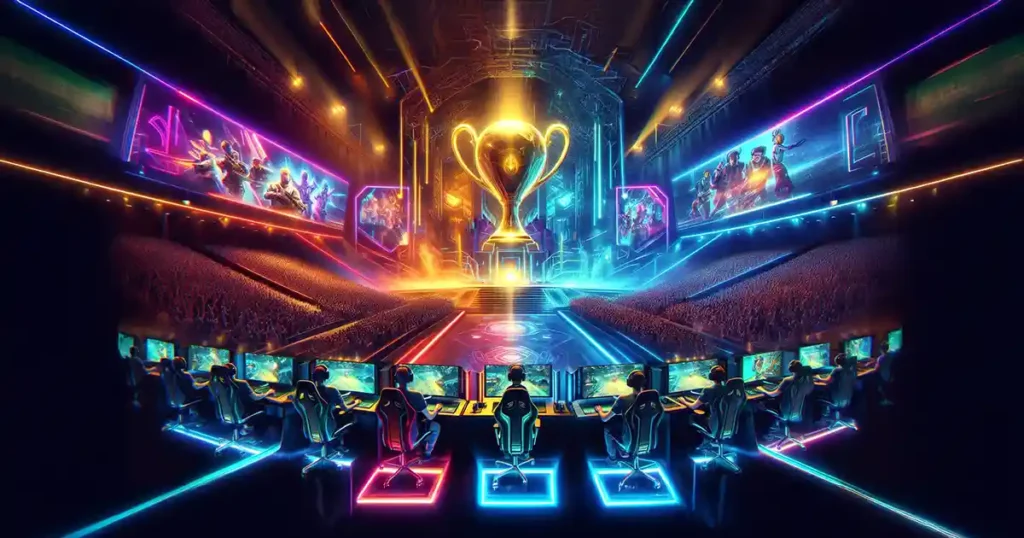Esports, or competitive gaming, has evolved from a niche hobby to a global phenomenon. It has transformed the gaming industry in a multitude of ways, shaping not only the games themselves but also the way people interact with games, the way companies develop games, and the way the entire industry is structured. From the early days of LAN tournaments to massive esports leagues watched by millions, esports has been at the center of this digital revolution.
In this article, we will explore how esports changed the gaming landscape, from its humble beginnings to its current status as a multi-billion-dollar industry. We’ll look at the rise of professional gaming, the development of esports infrastructure, the impact on game development, and the cultural shifts that esports has brought about. We will also discuss the major players in the esports world, the rise of esports media, and the growing influence of esports on mainstream culture.
1. The Humble Beginnings of Esports
Esports didn’t emerge overnight. Its roots trace back to the early days of video gaming, where competitive play was more about local tournaments in arcades or friendly multiplayer matches in basements and living rooms. However, it was the late 1990s and early 2000s when competitive gaming started to take its first steps into the spotlight.
The Red Annihilation tournament in 1997, which featured the popular first-person shooter Quake, was one of the first significant esports events. It was streamed via the internet and attracted significant attention. Shortly after, the emergence of dedicated gaming communities such as Battle.net (for Blizzard games like StarCraft and Warcraft) and Xbox Live provided the infrastructure for online multiplayer matches to become a global phenomenon.
One of the earliest and most significant tournaments was the Cyberathlete Professional League (CPL), founded in 1997. It began offering cash prizes for competitions in games like Quake and later Counter-Strike. These events laid the foundation for what would later become a fully-fledged global industry.
2. The Rise of Esports as a Professional Industry
By the mid-2000s, esports started to gain traction as a legitimate professional sport. As the internet became faster and more reliable, the ability to stream live events over platforms like Twitch (launched in 2011) began to provide a platform for millions of fans to watch competitive gaming from their homes.
One of the key catalysts for the rise of esports was the immense popularity of multiplayer online battle arena (MOBA) games, such as League of Legends and Dota 2. These games quickly became staples of the esports scene due to their deep, strategic gameplay and highly competitive nature. Games like Counter-Strike, StarCraft II, and Overwatch also contributed to the rapid expansion of esports tournaments and leagues.
The creation of large-scale esports events, such as The International for Dota 2, which offers multi-million-dollar prize pools, proved that esports could be more than just a hobby—it could be a professional career. Tournaments like League of Legends World Championship and Intel Extreme Masters (IEM) also played significant roles in boosting esports’ visibility.
3. The Role of Esports Organizations and Teams
As esports began to mature, so did the organizations behind it. Professional gaming teams became a major component of the esports ecosystem, with players signing contracts and receiving salaries, sponsorships, and endorsements just like traditional athletes. Teams such as Team Liquid, Cloud9, Fnatic, and T1 have become household names in the esports community.
These organizations began hiring coaches, analysts, and managers to guide their players, much like any traditional sports team. The development of esports infrastructure, including practice facilities, dedicated coaching, and even mental health support, has allowed players to treat gaming as a full-time profession, which is now a viable career path for many.
Additionally, the rise of sponsorship deals with major brands, from tech giants like Intel and NVIDIA to non-endemic brands such as Coca-Cola and Mercedes-Benz, has brought a wealth of investment into the esports world. These partnerships have provided funding for tournaments, increased media coverage, and helped expand the industry to new heights.
4. The Growth of Esports Streaming and Viewership
Streaming platforms, particularly Twitch, have revolutionized how esports events are consumed by audiences. As internet speeds improved, millions of viewers could watch their favorite teams and players live in action, all from the comfort of their homes. Twitch not only provided a platform for live streaming but also created a unique community for gamers to interact, discuss strategies, and share in the excitement of live events.
By 2014, Twitch had become a key player in the esports ecosystem, attracting top streamers, including Ninja, Shroud, and Sodapoppin. These personalities garnered massive followings, turning esports into an entertainment experience that extended beyond just the games themselves.
The rise of YouTube Gaming, Facebook Gaming, and other platforms further diversified the ways viewers could watch esports. Major tournaments like The International and League of Legends World Championships attract millions of live viewers, with global audiences from multiple countries tuning in to support their favorite teams.
5. Esports and Game Development: A Symbiotic Relationship
As esports grew, so did the relationship between competitive gaming and game development. Esports demanded games that could be played at a professional level, meaning developers had to create balanced and strategically rich games to meet the expectations of both casual players and pro gamers alike.
Games like League of Legends, Overwatch, Counter-Strike: Global Offensive, and Fortnite have become esports staples because of their deep mechanics, constant updates, and emphasis on player skill. Developers began to invest more heavily in community feedback, with many professional games evolving based on feedback from players, coaches, and analysts.
The rise of esports has also led to a more professional approach to game design, where the competitive scene is considered during development. For example, Riot Games, the creators of League of Legends, have made numerous adjustments to the game’s balance and mechanics to ensure the integrity of the competitive scene.
6. The Global Impact of Esports: A Cultural Phenomenon
One of the most significant ways esports has changed the gaming landscape is by turning gaming into a global cultural phenomenon. Esports is no longer limited to a niche community of gamers; it has become mainstream, attracting audiences from all walks of life.
Large-scale esports events like The International, League of Legends World Championship, and Call of Duty League are broadcast worldwide, attracting millions of viewers from countries around the globe. The esports industry has generated millions of dollars in revenue, and it continues to grow year after year.
Moreover, esports has sparked the growth of a new career path—professional gamers. Players are no longer just hobbyists but legitimate athletes, earning salaries and winning prize money. This shift has also led to the creation of educational programs and universities offering degrees in esports management, marketing, and game design, further legitimizing esports as a viable career.
7. The Future of Esports
As the esports industry continues to grow, its potential seems limitless. We’re seeing the expansion of esports into new regions, particularly in Asia, Latin America, and Africa, where the gaming scene is growing rapidly. The increasing popularity of mobile gaming has also brought esports to a wider audience, with games like PUBG Mobile and Mobile Legends becoming major competitive titles.
In the coming years, we can expect even more investment in esports, particularly in terms of infrastructure, broadcasting, and media rights. Esports arenas, such as the Esports Stadium Arlington in Texas, are being built to host live tournaments, complete with state-of-the-art technology for the best possible viewer experience. Virtual and augmented reality (VR/AR) will also play a larger role, providing even more immersive experiences for players and fans alike.
Esports is now an established part of the global entertainment industry, and its future looks incredibly bright.
Conclusion
Esports has come a long way from its humble beginnings. What was once considered a fringe activity is now a global industry, with millions of viewers, professional players, and multi-million-dollar prize pools. Its rise has not only changed the gaming landscape but has also reshaped how we view video games as an entertainment medium.
Esports has brought professional gaming into the mainstream, fostering new careers and inspiring an entire generation of gamers to pursue their passion at the highest level. It has created a cultural movement that extends far beyond the games themselves, with streaming platforms, sponsorship deals, and a growing fan base propelling esports to the forefront of entertainment.
As esports continues to grow, its impact on the gaming landscape will only increase. With the development of new technologies and expanding global markets, the esports industry is poised to reach new heights, changing the way we think about competition, entertainment, and community in the digital age.






